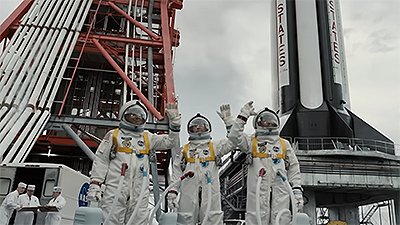2001: A Space “Oddity” (Part 1 of 2)
A Review of One of the Most Enigmatic and Evolutionary Movies Ever Made: Stanley Kubrick’s ‘2001: A Space Odyssey.’
One of the most enigmatic movies produced in the last century was the late Stanley Kubrick’s ‘2001: A Space Odyssey’
One of the most enigmatic movies produced in the last century was the late Stanley Kubrick’s “2001: A Space Odyssey” (somewhat based on Arthur C. Clarke’s book of the same title). When the movie was first screened in 1968, it was so visually stunning with its groundbreaking special effects, that the nigh-incomprehensible plot did not appear to diminish the dramatic impact it had on most audiences. Now that we are in the year 2001, there will undoubtedly be much comment on the film, with multiple showings of it on TV and maybe the big screen again.
As a wide-eyed, naïve 14-year-old watching the film on an immense “Cinerama” screen in Hollywood, California, I must admit it was a memorable evening at the movies back in 1968. It wasn’t until I recently saw the film again that I discovered how truly odd it is-and how it is a propaganda piece for evolution. I think I have come closer to understanding the difficult-to-follow plot-as well as coming closer to grasping the full evolutionary themes of the movie. Even the film’s title has become fuller in meaning than at first glance.
This long-yes, often dull movie-appears to be Kubrick’s encapsulation of human history, with also a glimpse into the future (although the filmmaker’s intent in this fable probably was not to foretell much about the future). It tells the story-accompanied by the rousing Teutonic music-of a spaceship on a long journey (“odyssey”) through the universe. But the film is really more about the odyssey of human civilization, and the plot features a strong belief in the evolutionary improvement of man.1 Perhaps the sub-title of the film, “2001: A Space Odyssey,” could be written (although perhaps not elegantly) as: “The odyssey of humankind from its ape-like ancestry to its evolutionary stage in the year 2001-and beyond.”
The plodding plot
The film opens with a lengthy scene of ape-like creatures (resembling “Australopithecines,” which many evolutionists claim were “missing links’-poorly costumed by Hollywood standards). A group of these ape-men awake one morning to see a tall, dark slab of metal in their midst. It obviously comes from an intelligence far greater than their own. The slab somehow spurs the ape-men to come up with inventions (e.g. using bones as tools, as well as weapons). As one of the bones is tossed high into the air, it “morphs” into a space ship—a suggestion that ape-men eventually evolved into more intelligent human beings, capable of building a highly designed spacecraft.
It is the year 2001 now. A similar slab is discovered on the moon. Sunlight shines on the monolith, sending a beam into space. A space ship follows a beam of mysterious signals in the direction of Jupiter, seemingly to discover the source of the intelligence behind this slab and the signals somehow energizing it.
The space ship-on its own odyssey through space-features an advanced, talking computer called “HAL” that attempts to kill the astronauts. A surviving astronaut is fast-forwarded to a time when he is an old man, lying on his deathbed, apparently living now at the other end of the universe. He is then transformed into a huge human embryo.
It is these final frames that pose the biggest riddle for viewers to solve. Here is one possible answer: the evolutionary “circle of life” has apparently concluded and man has fully evolved—or that a final level of evolutionary development is about to occur, represented by the baby. Since the major theme of the movie is to trace human evolution from its ape-like beginning, I am surmising that the last frames somehow represent the full evolution of man—to a final level of intelligence and/or insight.
The embryo, which floats in space back toward Earth, has an apparently super-large brain, adding overtones of Nietzsche’s evolutionary “superman” (which so influenced Hitler’s thinking). The theme music from Strauss’s “Also sprach Zarathustra” (’Thus spake Zarathustra,” 1896) further makes the point - this was ostensibly composed as an homage to one of Nietzsche’s Darwin-inspired writings of the same title (1883-84).2
When the spaceship approaches its destination- the planet Jupiter - there are some amazing “mystical” special effects, seemingly meant to symbolize that man has “arrived” at something like the “Omega point.” This is the idea of the man who can be called the “father of the New Age movement,” Catholic priest Teilhard de Chardin. Because of his belief in evolution (he was also a paleontologist, who was either taken in by the Piltdown ape-man hoax or was possibly even the hoaxer), he promoted a completely anti-Biblical view of man and of reality.
To Teilhard, all of reality was evolution; all of nature was propelled by some mysterious evolutionary force towards an ultimate culmination, which he called the “Omega point,” and mystically connected it to notions of the “cosmic Christ.” This evolutionary neopaganism, which owes much to eastern ideas of Nirvana and the like, is on clear display in this film.
(end of Part 1 - Continue to Part 2)
NOTE: This movie review was written without consulting the book’s sequels (2010: Odyssey two, 2061: Odyssey three, and 3001: The Final Odyssey). Because the film by Kubrick differs from the novel by Clarke (it’s reported that even Clarke did not quite understand the ending to Kubrick’s film), I have chosen not to read the three sequels and have attempted to understand the movie in its own context.
Reviewed by , who gratefully acknowledges the considerable assistance of Dr Carl Wieland and Dr Jonathan Sarfati, AiG - Australia in writing this review.
Footnotes
- The “2001” novelist, Arthur C. Clarke, has been an avid evolutionist and anti-creationist for years. Overall, Dr. Clarke has been quite hostile to Biblical Christianity. In the Free Inquiry magazine, volume 19, number 2, he stated that “one of the great tragedies of mankind is that morality has been hijacked by religion’; also: “I suspect that religion is a necessary evil.” Dr Clarke also declared in Science magazine, June 5, 1998 that the few creationists he has met, although they have been usually “nice,” makes him wonder if they are “mad, or only pretending to be mad. If I were a religious person, I would consider creationism nothing less than blasphemy. Do its adherents imagine that God is a cosmic hoaxer who has created that whole vast fossil record for the sole purpose of misleading mankind?” [Note: In common with many anti-creationists (and “progressive creationists” for that matter), Clark does not bother to find out what Biblical creationists actuallly claim before pronouncing his verdicts. For the creationist explanation of the fossil record, go to our Q & A section]
- Readers may also be familiar with the pagan religion of Zoroastrianism - the name similarity is not coincidental.
Recommended Resources

Answers in Genesis is an apologetics ministry, dedicated to helping Christians defend their faith and proclaim the good news of Jesus Christ.
- Customer Service 800.778.3390
- Available Monday–Friday | 9 AM–5 PM ET
- © 2025 Answers in Genesis





